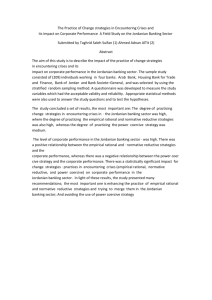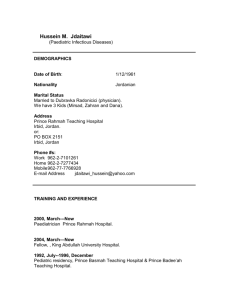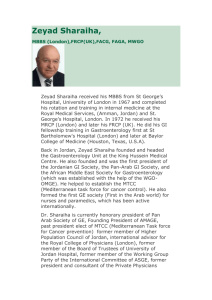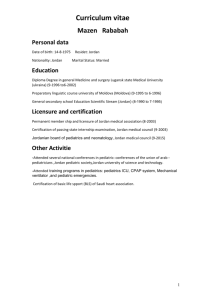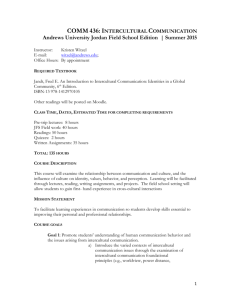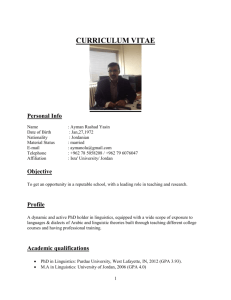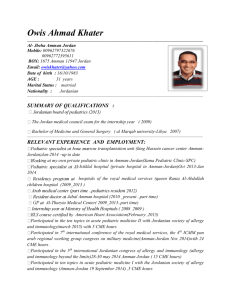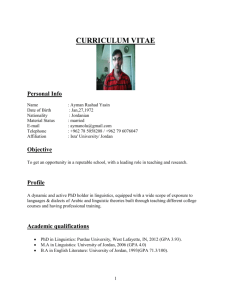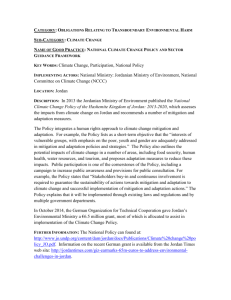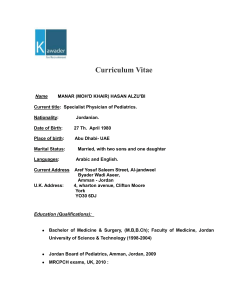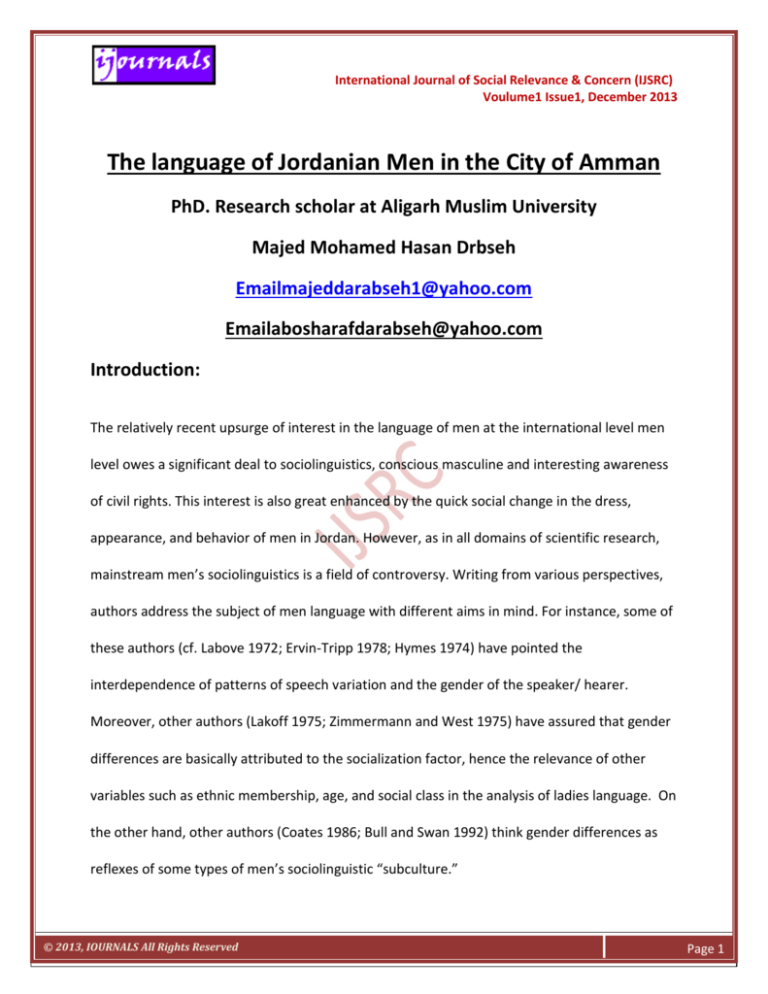
International Journal of Social Relevance & Concern (IJSRC)
Voulume1 Issue1, December 2013
The language of Jordanian Men in the City of Amman
PhD. Research scholar at Aligarh Muslim University
Majed Mohamed Hasan Drbseh
Emailmajeddarabseh1@yahoo.com
Emailabosharafdarabseh@yahoo.com
Introduction:
The relatively recent upsurge of interest in the language of men at the international level men
level owes a significant deal to sociolinguistics, conscious masculine and interesting awareness
of civil rights. This interest is also great enhanced by the quick social change in the dress,
appearance, and behavior of men in Jordan. However, as in all domains of scientific research,
mainstream men’s sociolinguistics is a field of controversy. Writing from various perspectives,
authors address the subject of men language with different aims in mind. For instance, some of
these authors (cf. Labove 1972; Ervin-Tripp 1978; Hymes 1974) have pointed the
interdependence of patterns of speech variation and the gender of the speaker/ hearer.
Moreover, other authors (Lakoff 1975; Zimmermann and West 1975) have assured that gender
differences are basically attributed to the socialization factor, hence the relevance of other
variables such as ethnic membership, age, and social class in the analysis of ladies language. On
the other hand, other authors (Coates 1986; Bull and Swan 1992) think gender differences as
reflexes of some types of men’s sociolinguistic “subculture.”
© 2013, IOURNALS All Rights Reserved
Page 1
International Journal of Social Relevance & Concern (IJSRC)
Voulume1 Issue1, December 2013
In Jordan, no attention is being paid to the language of men in the burgeoning domains of
Jordanian sociolinguistics beyond indications hare and there that the variable of gender is
important in performance. This may be due to the fact that men in this country are still, to a
large extent, culturally invisible. The matter fact, documentation on the language of men in the
Arab world at large is likely to be very seldom.
Jordan is a multilingual country where Jordanian Arabic, Caucasian, English and classical or
standard Arabic are used with varying degrees of frequency in Jordan (cf. Enajji1991). In this
paper I will concentrate on two major themes: (1) the situations in which ladies use a particular
language, as well as the constraints on this use, and (2) the social aspects of the image of men
in Jordanian Arabic, the lingua franca for all men in Jordan except cases of Caucasian living in
different areas in Jordan.
The paper is structured as follows: in the first section, some preliminaries concerning the
gender variable are given. In the second, the methodology used in data collection is briefly
described. Third one is an interpretation of the results of data analysis is presented. The last
one is the language of and about men is correlated with their overall socio-economic status.
© 2013, IOURNALS All Rights Reserved
Page 2
International Journal of Social Relevance & Concern (IJSRC)
Voulume1 Issue1, December 2013
The gender variable:
In the linguistics sense, one cannot say that men have their own specific language because
there is no difference between the language of men and the language of women; both of them
achieve the same kind of competence in a given language. However, as far as performance is
concerned, there are instances where the same meaning rendered differently by men and
women in terms of the linguistic expressions they use, that is, their speech. Throughout this
paper the term language is used to refer to speech.
Within sociolinguistics, the term gender is to be differentiated from the term sex. The later is
usually used to designate both male and female participants in a speech activity, whereas the
previous usually indicates to the notion of sex as a social variable. Gender is felt to be one of
the most influential factors in language use.
As overview of the literature on the gender variable discovers that sex differences have been so
far explained as reflexes of (1) social dominance, (2) social difference or more recently (3)
asymmetrical discourse. The first view illustrates the idiosyncrasies of ladies speech as typical
results of men dominated social status. The most popular example of this dominance approach
is Lak off (1975) who thinks that the bulk of gender differences in language to the phenomenon
of socialization in a male dominated society. The process of socialization permits the
internalization as well as the reinforcement of a strong sense of gender identity, which
© 2013, IOURNALS All Rights Reserved
Page 3
International Journal of Social Relevance & Concern (IJSRC)
Voulume1 Issue1, December 2013
automatically results in a certain speech behavior. In other words, men speech is a main form
of linguistic behavior because men are socially have more power than women.
Instances of this powerful linguistic behavior are likely to have more assertion/authority, less
hesitation, politeness and a tendency to use standard forms of language. At the same time,
these communicational behaviors, men believe that is part of their rights; to reflect their social
status.
Lak off’s explanation of sex linked differences in terms of dominance were further developed by
other sociolinguistics. Hass (1975) for example, illustrated speech development in small
children prior to the crucial age of live. His results show that distinct patterns are recognized in
the way girls and boys use their languages. As for Zimmermann and West (1975) they explain
the various linguistic characteristics of men language in terms of turn-taking roles in
conversations. Men are likely assertive in their speech because they are constantly subject to
being not interrupted by women in conversations.
Fishman (1980), on the other hand, thinks that differences in men’s and women’s language to
different ways of beginning and keeping conversations. Part of men role in mixed conversations
is to support what Fishman (1980) points to as bad work that is verbal behavior whose major
role is to maintain the flow of conversation.
The second approach to sex-linked differences is difference approach (Coates 1986, Maltz and
Broker (1982). Reveals within this approach have gone beyond the impact of society in
© 2013, IOURNALS All Rights Reserved
Page 4
International Journal of Social Relevance & Concern (IJSRC)
Voulume1 Issue1, December 2013
explaining the language of masculine and females have strongly assured that the two genders
simply have different sociolinguistic subcultures. Differently, men speech is not because their
social status is inferior to the females, but because they have different male subculture where
values and norms simply happen to be different from the female values and norms.
This is the finding of the early social differentiation of the genders, which gives rise to the single
gender per groups where each gender learns certain conversational strategies norms and
values.
Thirdly, approach to the role of sex in speech is a symmetrical approach, studied by Bull and
Swan (1992). Both authors based their suggestions on the writings of the masculine theorist
Mackinnon (1987). In the symmetrical approach, sex is not regarded as something fixed
through cultures, but as something that changes both through time and even within the
makeup of the same person. Gender differences, referring to the view, can be explained only by
concentrating on the various differences that sex makes in various types of speak because
various types of people.
A symmetrical discourse is based on analyses of situations where talk is highly institutionalized
and where the informants are symmetrically related, as in court rooms, doctors examining
rooms etc. where doctors and judges control speech as they have more power over defendants
and patients. For instance, in such situations, only the dominant parties use the dominant
language, not because of their social power but because of the constructed privilege that such
© 2013, IOURNALS All Rights Reserved
Page 5
International Journal of Social Relevance & Concern (IJSRC)
Voulume1 Issue1, December 2013
institutions give them. These situations sex does not have an important effect in courtroom,
men judges have the same privileges that women judges have.
Methodology:
The methodology of analysis used in this paper is based on three questionnaires, as well as
several interviews and tapes recordings. Not all the men participating in the questionnaires,
interviews, tape recordings were born in the city of Amman, where the data were collected
geographically dialect differences are thus not excluded.
The first questionnaire was submitted to a sample of 110 students, the second questionnaire
was submitted to 28 university teachers, and the third questionnaire was submitted to a
sample 54 women from different areas.
In addition to the questionnaires, 29 women were interviewed, 11 from each group that filled
out the questionnaires. During the interviews, men were asked questions meant to elaborate
© 2013, IOURNALS All Rights Reserved
Page 6
International Journal of Social Relevance & Concern (IJSRC)
Voulume1 Issue1, December 2013
on one or more points in the questionnaires or were asked questions that would confirm or
disconfirm the answers given the questionnaire forms.
I also used tape recordings. The men who participated in the recordings did not know that they
were being tape recorded. These men belong to different social classes and age groups. Some
of them are academics, some are business men, shop keepers, doctors, and others
retirements’. Moreover, both formal and informal situations were used. I used homes,
university, and the sport center as the main places for recordings. The choice of these places
simply coincident with places I usually prefer.
Analysis of data:
The data obtained from the questionnaires may be categorized into two main themes: 1. The
way Jordanian men use the three languages are available to them: Jordanian Arabic (JA),
Caucasian ( C ), and English (E), and the way Jordanian men perceive language use. Table 1 is
related to the first theme.
Interpretation of the data:
© 2013, IOURNALS All Rights Reserved
Page 7
International Journal of Social Relevance & Concern (IJSRC)
Voulume1 Issue1, December 2013
In my interpretation of the data obtained from the questionnaires, I will whenever appropriate
correlate the findings of the questionnaires with following Table below it.
Table 1 Frequency of language choice among Jordanian ladies (%)
Questions
Which language do you use at home?
working men
JA: 68
C: 19
retirements
JA: 79
C: 20
E: 23
E: 11
Is this choice motivated by habit?
Yes 81
Yes 86
Is this choice motivated by the need
Yes 11
Yes 27
Yes 38
Yes 10
J A 63
J A: 84
C: 10
C: 15
E: 39
E: 11
Which language do you use with your
J A: 58
J A 77
Friends?
C: 00
C:
17
E: 30
E:
16
to impress others?
Is this choice motivated by the need
To feel relaxed?
Which language do you speak to your
Children?
Which language do you use in mixed
J A: 35
J A: 88
Groups?
C:
C:
© 2013, IOURNALS All Rights Reserved
19
9
Page 8
International Journal of Social Relevance & Concern (IJSRC)
Voulume1 Issue1, December 2013
E:
56
E:
13
…………………………………………………………………………………………………………………..
Those of the tape recordings, I will begin by interpreting the percentages obtained from table 1.
According to question 1, Jordanian Arabic appears to be the language predominately used at
home in Jordan. This correlates with Ennaji; s (1990) says that Moroccan Arabic is the lingua
franca par excellence in Morocco. This similarly happened in Jordan. The fact that working men
use more English at home is obviously due to their social status as men with jobs and hence to
their relatively high level of education. However, a point of caution needs to be evoked here: in
1950s. 1960s and 1970s Jordanian old retirements were in the majority of cases nonworking
and hence generally no educated, but situation has dramatically changed in the early 1980sand
especially in the early 1990s: more and more retirements are likely to be more educated men,
than before three decades who either could not get the opportunity to learn English as now or
two decades more. This situation is obviously linked to overall economic situation of
Jordanians.
Further conclusion that may be drawn from the answers to question 1 is that Caucasian is not
much use at home: only 20 percent of working men and 21 of retirements use Caucasian at
home. Caucasian is used more among adults than with children. Note that the percentage of
women who speak Caucasian at home is higher nationalist people. It is also to be noted that
© 2013, IOURNALS All Rights Reserved
Page 9
International Journal of Social Relevance & Concern (IJSRC)
Voulume1 Issue1, December 2013
Moroccan men make abundant use of code mixing and switching calimed by (Lahllou 1990).
Similarly has happened to Jordanian men.
As for English only 10 percent of retirements use it at home, whereas 23 percent of working
men do. This of course correlates with men’s job requirements.
The answer to question 2 reveals that the use of Jordanian Arabic at home is mainly due to
habit. This again reflects the strong acceptance of Jordanian Arabic as a mother tongue and a
lingua franca.
The percentages corresponding to question 3 shown that men may use J A in order to impress
others. These are usually Caucasian phones who regard J A as more prestigious than Caucasian
given the diglossic relationship of the previous to standard Arabic, and hence to religion. Just
for information, that Caucasian language is mostly spoken language, and fewer who able to
speak, write and read the language, especially the adults and particular the nationalist people.
Caucasian people came to Jordan after the world war one; they fled their home land seeking for
safer place in Jordan and other places cross the world.
Never the less, 9 percent of working men share this opinion. An interesting conclusion from the
answer to the question 4 is that only working women appear to be conscious that the option of
a particular language is dictated by a need to feel relaxed. Question 4 is an important given that
the choice of the language that men use with their children is extremely revealing.
© 2013, IOURNALS All Rights Reserved
Page 10
International Journal of Social Relevance & Concern (IJSRC)
Voulume1 Issue1, December 2013
In a multilingual country like Jordan, some of the people prefer to speak with their children in a
language that they think will be useful for their future careers even if there are other languages
that their parents hold in esteem. Here again, the unique place of J A as a mother tongue and a
lingua franca is clear. However, the social status of men is also crucial here. Generally,
retirements or nonworking people use Jordanian Arabic 79%, whereas working men tend to use
it less (only 68%). On the other side, an important percentage of working men 39% use
frequently English with their children, whereas only 11% of retirements or nonworking does.
Caucasian is less and less used 10% by working men and 15% by retirements or nonworking.
The answers to question 6 show that the language that men use with their friends is
predominately Jordanian Arabic (72% of retirements or nonworking and 58% of working men).
More working men usually use English in such situations (32%), whereas 17% of retirements or
nonworking does. Caucasian is more used among friends and nationalist than with children
(10% by working women and 15% by retirement’s or nonworking). This fact reveals that when
women speak to their children, they are more concerned with future use of the language and
its practical utility than with anything else.
The percentages corresponding to the last question in Table 1 show that in mixed groups, there
is a sharp difference between working and nonworking men. In previous group, only 35%
percent of men use Jordanian Arabic, whereas 88% use the same language in the same
© 2013, IOURNALS All Rights Reserved
Page 11
International Journal of Social Relevance & Concern (IJSRC)
Voulume1 Issue1, December 2013
circumstances. Similarly, no less than 56% of working men use English in such groups, whereas
13% of retirements or nonworking does. As for Caucasian it is frequently more used by working
men in mixed groups than by retirements or nonworking in similar situations. In fact, only 9%
of retirements or nonworking uses Caucasian language in mixed groups. One illustration for this
is that men’s retirements or nonworking, more than working men need to assert themselves
given their social status, and hence tend to use a language that they think is more prestigious.
Although 88% percent of Jordanian nonworking men or retirements use Jordanian Arabic in
mixed groups, the majority of these ladies mix this language with English in order to sound
educated.
The major reason for this is that Jordanian men are more consciously aware than Jordanian
men of the social importance of English as a prestigious language because they are more in
need of this prestige than women. It is also to be noted that working men tend to use English –
Jordanian Arabic code-switching and mixing more than retirements or none educated in English
language. Furthermore, men generally avoid the use of words and expressions belonging
nonstandard language. It is perceived as “rough,” “uncivilized” and “uneducated” as opposed to
standard language, which is generally viewed as “intelligent,” “independent,” and
“sophisticated”. Men need to have an effect on the audience more than women. In
conversations, men are more anxious to have an effect on females than conversely. One
possible reason for this is that men are more evaluated on what they say than females.
© 2013, IOURNALS All Rights Reserved
Page 12
International Journal of Social Relevance & Concern (IJSRC)
Voulume1 Issue1, December 2013
One general conclusion to be taken from the percentages given in Table 1 is that the status of
men as working or nonworking (retirements that are not educated in English language)) has a
direct effect on their use of language inside and outside the home. In wider perspective, the
answers obtained from Table 1 show that the less social status a man has, the more standard
he uses.
As for Table 2, the answers to question 1 reveal that Jordanian men
Table0 elicitation of Jordanian men’s perception of language use
Questions
© 2013, IOURNALS All Rights Reserved
working men Retirements
Page 13
International Journal of Social Relevance & Concern (IJSRC)
Voulume1 Issue1, December 2013
What are the topics that you would like to
personal: 95
personal: 99
yes:
87
yes:
yes:
98
Discuss with men?
Do you believe that there are words or
102
Expressions that only men use?
Do you believe that there are words or
yes:
105
Expressions that only men use?
Do you feel embarrassed in a mix groups?
Yes:
31
yes:
89
Do you believe there is a language of men
yes:
77
yes:
99
In Jordan?
If your answer to the previous, how would
inferior: 19
inferior: 52
You Qualify this language :inferior, typical,
typical: 67
typical:
Superior?
Superior: 28
42
superior: 16
…………………………………………………………………………………………………………………………….
(Working or retirements) prefer to discuss personal matters with other men than with women.
This correlates nicely with the findings of the tape recordings, where the topics of
conversations in all men groups centered almost exclusively on children, personal relations,
family, jobs, and wives. However, I should add her that 74% of working men prefer to discuss
matters related to their jobs in mixed groups. Another correlation between the questionnaires
and the tape recordings is that the later that topic shifts in all men groups conversations were
rather abrupt, a fact which shows that in all men groups conversations appear to be more
relaxed and conversation situations are created more easily.
As for answers to question 2 they showed that Jordanian men (working or retirements) are
conscious of the fact that there are words and expressions that are used only by females. Most
© 2013, IOURNALS All Rights Reserved
Page 14
International Journal of Social Relevance & Concern (IJSRC)
Voulume1 Issue1, December 2013
women gave examples like kallili ‘my pal’ or taboo words like rooh ‘get out’ According to the
answer obtained, men also trend to use more slang and violent speech than women.
Similarly, answers to question 3 revealed that men assume that there are words and
expressions that are typically used by men. According to the examples that were given, I can
cite yaa (interjection of surprise), basitaa! ‘I will get you’, ahij (interjection). These samples
correlate with the results of the tape recordings: it looks that the majority of the vocabulary
items that occur in the recorded speech of men are related to child rearing, teaching, politics,
dressing and home working. Men also make a great use of intensifiers such as iktheer ‘a lot’
shwija ‘a little’ iawah ‘not a bit’ etc., which show their feelings and emotions. Further, men tend
to use diminutives are noticed like ‘shwi ‘little’ ‘biggest’ etc. Diminutives are noticed in the
speech of men even in questions: kumm? ‘How big’? Men also prefer euphemistic expressions
and polite forms. Another correlation between the questionnaires and the interviews is that
when asked to relate the most significant event in their lives, most men revealed likely some
emotion.
According to the answers to question 4, more retirements or nonworking 86% than working
women 29% feel embarrassed in mixed groups. Most of the reasons given are “I cannot follow
men’s lines of argumentation,” what men say is boring” “I am afraid of being misinterpreted,”
© 2013, IOURNALS All Rights Reserved
Page 15
International Journal of Social Relevance & Concern (IJSRC)
Voulume1 Issue1, December 2013
etc. It is also to be noted that in mixed groups women talk far less than males. Ladies are more
easily interrupted than males, a fact which mentions Zimmermann and West’s (1975) states
that in mixed groups males trend to interrupt females as a result of which the later often resort
to silence. The percentages corresponding to question 5 are very revealing. A good percentage
of men 77% of working men and 99% of retirements or nonworking believe that there is a
language of men in Jordan. These results correlate with findings of questions 3 and 4 Table 2.
The last question in Table 2 shows that more retirements or nonworking 52% than working men
19% qualify the language of men as inferior, whereas more working men 67% than nonworking
or retirements 42% qualify it as typical of men. Interestingly, enough, only 16% of nonworking
or retirements and 28% of working men believe that their language is superior.
Generally, the conclusion is to be drawn from the answers to the questions that they speak
differently from men. The answers also show a prevailing sense of solidarity and sharing among
males.
Men language: a reflection of their social status:
In Jordanian society, as in any other society, men and women hold different positions and
perform different functions. Naturally, different values are attached to these functions, more
likely to the detriment of men. In Jordan, many actions, practices, rules, and customs, as well as
© 2013, IOURNALS All Rights Reserved
Page 16
International Journal of Social Relevance & Concern (IJSRC)
Voulume1 Issue1, December 2013
application of the law, contribute directly to limiting males role. Socially, Jordanian men are
relegated to first position in key areas like the family, public circles and law courts. The social
status and identity of Jordanian men largely depends on whether or not they are married,
whether or not they have children and whether or not they have a job.
Overall, public recognition is often given to men, not women. Legally, unmarried men are fully
independence and they are recognized as responsible before the law, even in cases where they
have some economic problem. To have a pass port a Jordanian men age of sixteen do not need
the permission of their fathers, his father, or any of two men relative or non relative as
witnesses. Further, men age of sixteen acts as witnesses in court of law as the adults.
There is a relationship of “owner-owed” in men-women interaction in Jordan. For instances,
like Zalameh ‘unqhu man in his possession’ is accepted, but mara unqa woman in her
possession is not. A popular saying in Jordanian Arabic is ja flan la taqarrb la melk flan u la
taqrrab la mart flan ‘do not touch another man’s property and don not touch another man’s
wife’.
In Jordan, the level of education is still highly correlated with the possibility of having a job. One
thing to be noted in relation to Jordanian men education is that it is very rare for women to be
better educated than their husbands. A consequence of this is that, on the one hand, women
earn less, and on the other side, they tend to have little opportunity for promotion. In fact,
© 2013, IOURNALS All Rights Reserved
Page 17
International Journal of Social Relevance & Concern (IJSRC)
Voulume1 Issue1, December 2013
women tend to think more of their husbands’ promotions than of their own promotions even if
both partners hold the same position in the same institution.
A natural result of this state of affairs is that Jordanian men tend to look assertiveness. This is
reflected in speech, mainly in the excessive use of more polite forms of speech and
euphemisms. (See the answers to questions 3, 5, and 6 in Table 2. Note here that politeness is a
concept that can be judged only in relation to a speech social context. For instance, men’s
politeness is to be perceived as different forms of women’s because only the latter stems from
lack of assertion.
Jordanian men’s speech is polite because in Jordanian society men are brought up to talk in a
“manlike” way and are expected to act and to talk accordingly. Expressions like zalmet beit ‘son
of their house’ (a girl of good upbringing), aben nas ‘son of people’ (a boy of a good back family
ground’ are highly sought after even by men themselves.
Moreover, men are differential in the use of forms of address. They use more terms like sidi not
only as a form of respect but also as an attempt to keep distance. Men also like to prefix names
of females with the titles like Y duktor ‘Doctor’. This correlates with men’s general tendency to
use compliments more frequently than females in certain position, because Jordan is
considered to be as a conservative country told by (Herbert 1990). Further, in both all men and
© 2013, IOURNALS All Rights Reserved
Page 18
International Journal of Social Relevance & Concern (IJSRC)
Voulume1 Issue1, December 2013
mixed groups, Jordanian men make extensive use of the expressions aiwah ‘all right’ mish haike
‘isn’t it’? Such expressions are much more elliptical than the English tag questions, but they
share with these tags the context of use. It is true that Jordanian men also use such expressions
but not as frequently as men and also seldom in unmarked situations where the social power of
men is not jeopardized. Socially, these expressions have a function and a meaning; they show
the typical communication strategies that men use: less hesitation, more assertion, and the
seeking of approval forms the participants in conversations. All this largely reflects men are
having more assertiveness than women and their constant feeling of insecurity in cross gender
conversations (see the percentages to questions 4 in Table 2. The Jordanian socio-cultural
background does not develop in men a feeling of self dependence and initiative.
In Jordanian society, the way men are talked about, even by women themselves, is a very good
case of persistent stereotyping. Stereotypes reflect shared expectations that members of a
specific society have as to what men and women are like and what is expected of them.
Stereotypes are, thus, social reflexes of social divisions and social attitudes, which in turn are
directly reflected in language use. This is an area where language and society interact
significantly. Stereotypes stem from social norms and behaviors and it is very difficult for a
stereotype to die a natural death. Jordanian society is positively biased toward men and
negatively biased toward women. Men have power over women at the level of political
leadership and legal rights and even in streets. Generally, speaking the attributes and values
associated with women are more negative than the one associated with males.
© 2013, IOURNALS All Rights Reserved
Page 19
International Journal of Social Relevance & Concern (IJSRC)
Voulume1 Issue1, December 2013
It is true that, unlike English and French where man and homme ‘man’ refer to both men and
women. However, Jordanian Arabic is full of expressions that reflect stereotypes relating to
women. These stereotypes vary greatly from rural, bedowin, to urban areas, as well as a cross
the class categories of women. For instance, although there is no generic usage of masculine
terms to the extent it exists in other languages, the following expressions are attributed to
women and do not have equivalents that allude to men
Hadak Rajil!
‘That’s only man!’
Hadik mara!
That’s only woman!
Suq I’linisaa! ‘the market of women’
Suq IZlaam!
‘the market of men!’
Hadak mra mish, Zalameh
a. That’s woman not a man
b.
Negative connotation an insult!
b.Hada Zalameh
That’s a man not a woman’: positive connotation; an attribute
© 2013, IOURNALS All Rights Reserved
Page 20
International Journal of Social Relevance & Concern (IJSRC)
Voulume1 Issue1, December 2013
In Jordanian context, one of the most widespread stereotypes is that men talk more than
women. This is so much believed to be truth that any devalued or uninteresting talk is qualified
as hadik mra Cf. {1} above. Although the literal meaning of this expression is ‘women’s talk’ it is
used to refer to anything ‘unimportant’ or uninteresting’. However, they have been extensively
illustrated by many researchers (e.g. Hilpert et al 1975; Strodbeck 1951; Argyle et al. 1986;
Swacker 1975) have shown that men talk far more than women. The expression hadak mra.
Mish Zalameh (c.f.{5} above said to a man is very strong; it donates the fact that women are
associated with anything unworthy. The meanings attributed to words and expressions and the
way these words and expressions are used create a powerful ideology that is difficult to
eradicate or even change. In Jordanian society, this ideology creates a world view where men
have physical and moral power over women.
Other similar examples are given below it.
Iwa bes helwah
‘At least she is beautiful’
Iwa bes maah filus
‘At least he is rich’
Anna bes Zalameh
‘I’ am just a man’
© 2013, IOURNALS All Rights Reserved
Page 21
International Journal of Social Relevance & Concern (IJSRC)
Voulume1 Issue1, December 2013
Anna bes mra
‘I’am just woman
Iftah itariq (said only by men)
‘let women hide themselves so that men can enter the house’ (lit make the way free)
Pointing to Lakoff (1975), gender language is language that is derogatory to women as a group.
The expressions 6-8 above are not sexist in their literal meaning, but their use certainly is. On
the other side the terms sibian ‘boys’ and iwlaad ‘boys’ refer to both boys and girls, whereas
The terms bannat ‘girls’ sabiyaat ‘girls’ refer only to girls and hence marked. Such terms denote
a sexist attitude.
Many masculine words and expressions are used in a generic sense. For instance, Zalameh
ttalim ‘men of education,’ although the majority of teachers in Jordanian primary and
secondary schools are composed of women. There is also geel ilmustakbel ‘ the future
generation’ or men of the future which excludes women at the level of linguistic expressions.
Further, many expressions associated men, but not women, with children: nasa wa iwladha
‘men with her children’. In every day speech, Jordanian men are often defined in relation to
their fathers or husbands, whereas men are defined in terms of the jobs they hold in society.
In addition, the use of title aniseh ‘unmarried girl’ and lady ‘saideh’ ‘married woman’ is
discriminatory in the absence of equivalent terms distinguishing unmarried from married men.
One implication of this is that women need to be identified at first sight, as married or
© 2013, IOURNALS All Rights Reserved
Page 22
International Journal of Social Relevance & Concern (IJSRC)
Voulume1 Issue1, December 2013
unmarried whereas; men are not subject to this. In fact, this clearly implies that the material
status of Jordanian women is crucial to their public social identity, whereas the material status
of men is not.
Stereotypes relating to how Jordanian women are perceived and talked about are dangerously
reinforced in children’s textbook. Females (both girls and women) are always revealed
performing domestic duties like cleaning the floor and washing up the dishes; whereas males
(both boys and men) are shown piloting an airplane, playing violent games, reflect this attitude
and so on. Words and expressions that are little boys utter like banaat fashlat ‘girls are weak’
and so on. There is a marked continuity between the speech of girls and those women as well
as between the speech of boys and that of men. The early differences between the behaviors of
girls and boys are only naturally carried over by women and men, a fact that explains
miscommunication that often characterizes cross-sex interaction.
The image of Jordanian women in the national media is in line with the widespread
stereotypes. The media related industries are over whelming males dominated. For instance,
most commentators of commercials are men. Women are represented as ‘petty’ users of
products or as commercial accessories accompanying a car or well coming important looking
business men. Jordanian women have an ambiguous status vis-à-vis authority they have
authority over children and maids; they are responsible for house maintenance, hence the
expressions malek addar ‘home owner’ in this capacity only. However, politically women are
largely invisible. It was only in the early 1990s that a tiny percentage of women were elected
© 2013, IOURNALS All Rights Reserved
Page 23
International Journal of Social Relevance & Concern (IJSRC)
Voulume1 Issue1, December 2013
directly by people and few others were getting help by the state. Up to now few of women
have managed to secure a seat in parliament.
At the social level, the status of women in Jordan is also ambiguous; this is appropriately
reflected in the popular saying mra kwiseh u mra laa ‘a woman is good and a woman is bad’.
This gives women an uncertain social status, similar to their uncertain political status. Further, a
married women’s identify depends on crucially on her relationship with her husband’s: anna
mrat zalameh ‘I am a man’s wife’, said in contexts where a woman needs to state that she has
social status, shows the women subordination to men.
Note for instance, the ridiculous connotation of zalameh mra ‘I am a woman’s husband’.
Overall, there is a great uncertainty as to Jordanian women’s sociolinguistic place and status.
This situation is maybe wanted. It is a situation that is very much reminiscent of what Jaworski
(1990: 36) mentioned: “should women be talked about, or discussed in any meaningful,
relevant terms, they would have to be unambiguously identified as women, and this would
pose a threat to the identity and coherence of the male status-quo world”.
In Jordan, as in all societies, the usual reaction to the ambiguous is taboo, unspeakable, and
silence. To large extent, Jordanian women are seen not heard especially in the public areas
involving ritual speech.
© 2013, IOURNALS All Rights Reserved
Page 24
International Journal of Social Relevance & Concern (IJSRC)
Voulume1 Issue1, December 2013
The religious factor affects Jordanian men speech in a very apparent way. Their attachment to
the Muslim religion is reflected in the religious terms used and a tendency to defend a specific
point. Generally, men’s speech greatly varies according to whether those men are visible
religiously committed or not.
Conclusion:
© 2013, IOURNALS All Rights Reserved
Page 25
International Journal of Social Relevance & Concern (IJSRC)
Voulume1 Issue1, December 2013
The language of men in the city of Amman offers a very good case study in sociolinguistics. The
urban area of Amman is to a large extent reprehensive of Jordanian urban areas. On a great
scale, differences in the speech of Jordanian men and women cannot be attributable solely to
biological differences: it is very difficult to illustrate the linguistic behavior of Jordanian males
and females without describing the socio-economic setting that dictates this behavior. In fact,
gender-role behaviors and attitudes are socio-culturally defined, and the socio-cultural status of
men in Jordan is largely showed in their speech.
References:
© 2013, IOURNALS All Rights Reserved
Page 26
International Journal of Social Relevance & Concern (IJSRC)
Voulume1 Issue1, December 2013
1. Acker, S. (1980). Women the other academic, British Journal of sociology of education 1 (1),
81-91.
2. Aikio, M. (1992). Are women innovators in the shift to a second language? A case study of
reindeer Sami women. Language, sex and society, international Journal of sociology of language
94, 43-61.
3. Argyle, M; et al. (1968). The effect of visibility on interaction in a dyed . Human relations 21,1.
4. mBull, T. and Swan, T. (eds) (1992). Language sex and society, international Journal of the
sociology of language 94.
5. Brouwer, D and Van Hout, R. (1992). Gender related variation in Amsterdam vernacular.
International Journal of sociology of language 94, 99-122.
6. Cheshire, J. (1984). The relation between language and sex in English. In applied socio
linguistics, P. Trudgill (ed). London academic Press.
7. Coates, J. (1986). Women and men language. London. Longman.
8. Conklin, N. (1974). Toward a feminist analysis of linguistic behavior. University of Michigan
paper in women studies1 (1), 51-73.
9. Duran, J. (1981). Gender-natural terms. In sexist language. A modern philosophical analysis,
M. Vetterling – Braggain (ed). Little field, T.X: Adams.
10. Enajj, M. (1988). Language planning I n Morocco and changes in Arabic. International
Journal of sociology of language, 74, 9-39.
© 2013, IOURNALS All Rights Reserved
Page 27
International Journal of Social Relevance & Concern (IJSRC)
Voulume1 Issue1, December 2013
(1991). Aspect of multilingualism in the Meghreb. International Journal of sociology of language
87, 7-25.
11. Ervin-Tripp,S. (1978). What do women sociolinguistics want? Prospect for a research field.
International Journal of sociology of language 17, 17-28.
12. Fishman, P. (1980). Conversational insecurity. In language: social psychological perspectives,
H. Giles et al. (ed). 127-132. Oxford: Pergamon.
13. Goffman, E. (1979). Gender adevertisment. Camberidge, M A: Harvard University Press.
14. Guttenage, M; and Bray, H. (1976). Undoing sex stereotypes. Research and resources for
educators. New York: McCraw Hill.
15. Hass, A. (1979). Male and female spoken language differences: stereotypes and evidence
psychological Bulletin 86 (3), 616-626.
16. Herbert, R. K. (1990). Sex-based differences in compliment behavior. Language in society
19, 201-224.
17. Hilbert, A; et al. (1975). Participants’ perception of self and partner in mix sex dyads. Central
state speech Journal 26, 52-56.
18. Hymes, D.H. (1974). Foundation of sociolinguistics: An ethnographic approach. Philadelphia:
University of Pennsylvania Press.
19. Ide, S. Hori, M; Kawasaki, A. Ikuta, S. and Haga, H. (1986). Sex difference and politeness in
Japanese. International Journal of sociology of language 58, 25-36.
© 2013, IOURNALS All Rights Reserved
Page 28
International Journal of Social Relevance & Concern (IJSRC)
Voulume1 Issue1, December 2013
20. Jaworski, A.(1992). How to silence a majority: the case of women. International Journal of
sociology of language94, 27-41.
23. Labo, W. (1972). Sociolinguistic patterns. Philadelphia: University
21. Komisar, L. (1971). The image of women in advertising. In women in sexist society. V.
Gornick and B.K. Moran (ed).New York: Basic book.
22. K ress, G; and Hodge, R. (1979). Language as ideology. London: Routledge and Kegan Paul.
of Pennsylvania Press.
24. Lahlou, M. (1991). A morph-syntax study of code switching between Morocco Arabic and
French. Unpublished PhD. Thsis, University of Texas Huston.
05. Lakoff, R. (1975). Language and women’s place. NEW YORK: Harper and Row.(1977).
Women’s language; language and style 10, (4), 000-247).
26. Mackinnon, C. (1987). Feminism unmodified. New Haven: Yale University Press.
27. Maltz, D.N; and Broker, R.A. (1982). A cultural approach to male-female miscommunication.
In language and social identity, J.J Gumperz (ed). Cambridge: Cambridge University Press.
28. Martyna, W. (1978). What does “he” mean ? use of generic masculine. In Journal of
communication 28(1), 131-138.
29. Miller, C; and Swift, K. 1977). Words and women. London: Gollancz.
© 2013, IOURNALS All Rights Reserved
Page 29
International Journal of Social Relevance & Concern (IJSRC)
Voulume1 Issue1, December 2013
30. Nordenstam, K. (1992). Male and female conversational style. International Journal of
sociology of language 94, 75-98.
31. O’Barr, W. and Atkins, B. (1980). “Women’s language or power less language”? in women
and language in literature and society, McConnell-Ginet, A. et al. (ed). New York: Braeger.
32. Ritchie Key, M. (1975). Male/female language. Metuchen, NJ: Scarecrow.
33. Sadiqi, F. (1991). The spread of English language in Morocco. International Journal of
sociology of language 87, 99-114.
34. Smith, P.M. (1985). Language, the sexes and society. New York: Blackwell.
35. Sole, Y. (1978). Socio-cultural and socio-psycological factors in differential language
retentiveness by Sex. International Journal of sociology of language 17, 29-44.
36. Strodbeck, F.L. (1951). Husband-wife interaction over revealed differences. American
sociological review 16, 468-473.
37. Swacker, M. (1975). The sex of the speaker as a sociolinguistic variable. In language and sex:
difference and dominance, B. Thorne and N. Henley (ed). Rowley, MA: New Burry House.
38. Tannen, D. (1978). Ethnic style in male-female conversation. International Journal of
sociology of language 17, 217-231.
39. Trabelsi, C. (1991). De quuelques aspects du lanngage des femmes de Tunis. International
Journal of sociology of language, 87, 78-98.
© 2013, IOURNALS All Rights Reserved
Page 30
International Journal of Social Relevance & Concern (IJSRC)
Voulume1 Issue1, December 2013
40. Valian, V. (1981). Linguistics and feminism . in sexist language: A Modern philosophical
analysis. Little filed , TX Adams.
Warro Garcia, G; and Frossch, S.F, (1978). Sex, color, and money; who’s perceiving what, or
where did all the differences go(to)? International Journal of sociology of language17, 83-90.
41. West, C. (1984). When doctor is a “ lady” Symbolic interaction 7(1).
42. Woods, N. (1989). Talking shop. In women in their speech communities, J. Coates and D.
Cameron (eds.) 141-157. London: Longman.
43. Zimin, S. (1981). Sex and politeness: factors in first and second language use. International
Journal of sociology of language 27, 35-58.
44. Zimmermann, D.H; and West, C. (1975). Sex roles, interruptions and silence in
conversations. In language and sex: difference and dominance, B. Thorne and N. Henley (eds).
Rowley, MA: New Bury House.
© 2013, IOURNALS All Rights Reserved
Page 31
International Journal of Social Relevance & Concern (IJSRC)
Voulume1 Issue1, December 2013
© 2013, IOURNALS All Rights Reserved
Page 32
International Journal of Social Relevance & Concern (IJSRC)
Voulume1 Issue1, December 2013
© 2013, IOURNALS All Rights Reserved
Page 33

